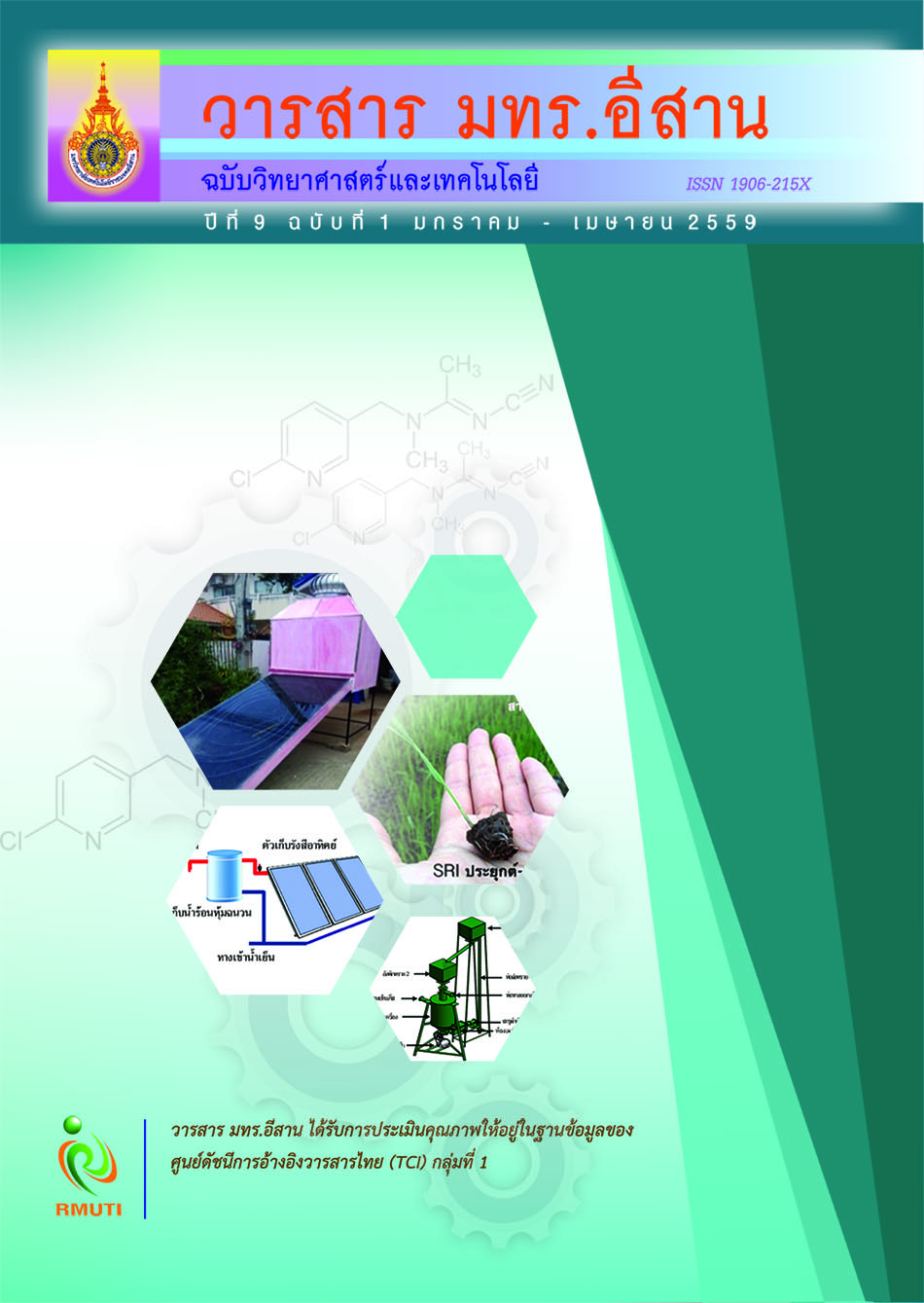การสังเคราะห์วงจรเสมือนอุปกรณ์แบบต่อลงกราวนด์ด้วย CCTA (The Realization of Grounded Simulator Based-on CCTAs)
Main Article Content
Abstract
บทคัดย่อ
บทความวิจัยนี้นำเสนอการสังเคราะห์วงจรเสมือนอุปกรณ์แบบต่อลงกราวนด์ โดยวงจรสามารถทำหน้าที่
เป็นตัวเก็บประจุ ตัวเหนี่ยวนำ และตัวต้านทานแบบลบที่ขึ้นอยู่กับความถี่ ขึ้นอยู่กับการเลือกอุปกรณ์
พาสซีฟในวงจร โครงสร้างวงจรประกอบด้วย วงจรขยายความนำถ่ายโอนสายพานกระแส หรือ CCTA
จำนวน 2 ตัว และอุปกรณ์พาสซีฟต่อลงกราวนด์อีก 3 ตัว วงจรสามารถปรับค่าของอุปกรณ์ได้ด้วย
วิธีทางอิเล็กทรอนิกส์ โดยการปรับกระแสไบแอสของ CCTA อีกทั้งการทำงานของวงจรไม่เปลี่ยนแปลง
ตามอุณหภูมิของสภาวะแวดล้อม วงจรจึงเหมาะที่จะนำไปประยุกต์ใช้ในระบบสื่อสารและสร้างเป็นวงจรรวม
นอกจากนี้ได้นำเสนอตัวอย่างการใช้งานของวงจรเสมือนอุปกรณ์ในวงจรกรองความถี่ตํ่าผ่าน ผลการจำลอง
การทำงานของวงจรเสมือนอุปกรณ์ด้วยโปรแกรม PSPICE พบว่าสอดคล้องกับทฤษฎีที่ได้วิเคราะห์
เป็นอย่างดี
Abstract
This article presents the realization of grounded simulators that can function as
capacitance, inductance and frequency dependent negative resistance. The function of
circuits depend on chosen passive elements. The proposed simulators are provided
2 current conveyor transconductance amplifier or CCTA and 3 grounded passive
elements. Furthermore, the proposed circuits not only can be electronically controlled
with bias current of CCTAs but also temperature-insensitive. Therefore, these circuits
are suitable for IC architecture and are used in communication system. The low-pass
filter as an application example is included. The results of PSPICE simulation are
accordant with theoretical analysis as well.
Article Details
References
multiplier and frequency-dependent negative-resistance simulator using the
current-controlled current conveyor. Microelectronics Journal. Vol. 30. pp. 689-873
Ayten, U. E., Sagbas, M., Herencsar, N. and Koton, J. (2011). Novel floating FDNR,
inductor and capacitor simulator using CBTA. International Conference on
Telecommunications and Signal Processing (TSP) 2011 34th. Istanbul, Turkey,
18-20 Aug. pp. 312-316
Ayten, U. E., Sagbas, M., Herencsar, N. and Koton, J. (2012). Novel floating general
element simulator using CBTA. Radioengineering. Vol. 21. No. 1. pp. 11-19
Cam. U., Cicekoglu, O. and Kuntman, H. (2000). Universal series and parallel immittance
simulators using four terminal floating Nullors. Analog Integrated Circuits and
Signal Processing. Vol. 25. pp. 59-66
Cam, U., Cicekoglu, O. and Kuntman, H. (2001). Novel lossless floating immittance
simulator using only two FTFNs. Analog Integrated Circuits and Signal Processing.
Vol. 29. pp. 233-235
Cam, U., Kacar, F., Cicekoglu, O., Kuntman, H. and Kuntman, A. (2004). Novel two
Otra-Based grounded parallel immittance simulator topologies. Analog Integrated
Circuit and Signal Processing. Vol. 39. pp. 169-175
Cicekoglu, O., Toker, A. and Kuntman, H. (2001). Universal immittance function simulator
using current conveyors. Computer and Electrical Engineering. Vol. 27. pp. 227-238
Hou, C. L. and Wang, W. Y. (1998). Realization of floating immittance function simulators
using CCII+. Microelectronics Journal. Vol. 29. No. 1-2. pp. 59-63
Jaikla, W. and Siripruchayanun, M. (2007). Realization of current conveyor-based floating
simulator employing grounded passive elements. The Proceeding of ECTI con
2007, The 3rd CCTI Annual Conference. Chiang Rai, Thailand. pp. 89-92
Myderrizi, I. and Zeki, A. (2014). Electronically tunable DXCCII-based grounded
capacitance multiplier. AEU-International Journal of Electronics and
Communications. Vol. 68. Issue. 9. pp. 899-906
Pal, K. (2004). Floating inductance and FDNR using positive polarity current conveyor.
Active and Passive Electronic Components. Vol. 27. No. 2. pp. 81-83
Prokop, R. and Musil, V. (2005). New modern circuit block CCTA and some its
applications. The Fourteenth International Scientific and Applied Science
Conference - Electronics ET’2005. pp. 93-98
Psychalinos, C., Pal, K. and Vlassis, S. (2008). A floating generalized impedance converter
with current feedback amplifiers. AEU-International Journal of Electronics and
Communications. Vol. 62. No. 2. pp. 81-85
Saad, R. A. and Soliman, A. M. (2010). On the systematic synthesis of CCII-based floating
simulators. International Journal of Circuit Theory and Applications. Vol. 38.
No. 9. pp. 935-967
Sagbas, M., Ayten, U. E., Sedef, H. and Koksal, M. (2009). Floating immittance function
simulator and its applications. Circuits Systems and Signal Processing. Vol. 28.
No. 1. pp. 55-63
Srisakolteaw, S., Lawanwisut, S., Buriphan, N. and Siriphuchayanun, M. (2013).
A current-mode electronically controllable multifunction biquadratic filter using
CC-CCTAs. RMUTI Journal. Vol 6. No 1. pp 1-10
Tangsrirat, W. (2013). Floating simulator with a single DVCCTA. Indian Journal of
Engineering & Materials Sciences. Vol. 20. pp. 79-86
Vladimir, I. P. and Michael, M. G. (1994). A Current-Mode FDNR Circuit Element using
Capacitive Gyrators. 1994 IEEE International Symposium on Circuits and
Systems. pp. 409-412
Yuce, E. (2006). On the realization of the floating simulators using only grounded passive
components. Analog Integrated Circuits and Signal Processing. Vol. 49. pp. 161-166
Yuce, E., Cicekoglu, O. and Minaei, S. (2006). CCII-Based grounded to floating immittance
converter and a floating inductance simulator. Analog Integrated Circuits and
Signal Processing. Vol. 46. No. 3. pp. 287-291
Yuce, E. (2007). On the implementation of the floating simulators employing a single
device. AEU-International Journal of Electronics and Communications.
Vol. 61. No. 7. pp. 453-458
Yuce, E., Minaei, S. and Cicekoglu, O. (2006). Resistorless floating immittance function
simulators employing current controlled conveyors and a grounded capacitor.
Electrical Engineering. Vol. 88. pp. 519-525

